#All India Judges Association
Explore tagged Tumblr posts
Text
Who Is Eligible to Join the Association of Judges of India?

The Association of Judges of India is a prestigious organization committed to serving and supporting judges nationwide. But who completely is fit to join this esteemed group? To maintain legal liberty, uprightness, and responsibility, the All India Judges Association plays an important function in promoting the righteous and professional principles of the judges.
To uphold the important guidelines and integrity of the organization, there are certain requirements and norms that judges must meet to be worthy of membership. If you're understanding who can join the Association of Judges of India, keep reading to determine more about potential members' necessities and expectations.
Understanding of All India Judges Association
All Association of Judges of India is a cumulative body representing judges from discrete courts across the country. This organization aims to support judges by focusing on their professional needs, defending their rights, and providing opportunities for endless knowledge and growth.
Joining the All India Judges Association offers abundant benefits, such as an approach to a wide range of resources, containing juridical research materials and best practices in legal presidency. Members also have the time to engage in conferences, seminars, and discussions that advance professional growth and networking accompanying peers from various regions.
All India Judges Association also plays a critical role in describing the interests of judges at individual levels of government. By being a part of this federation, judges can guarantee their voices are heard and influence the enhancement and uprightness of the legal arrangement in India.
Who Can Join the All India Judges Association?
The All India Judges Association welcomes judges from diverse levels of the judges, offering a platform for professional development and representation.
Here are the types of legal officials eligible to join this esteemed association:
1. Judicial Officers of Subordinate Courts: Judges serving in subordinate courts, such as section courts, can apply for membership. These involve District Judges, Additional District Judges, and additional legal officers of equivalent rank.
2. High Court Judges: Judges serving in the High Courts of diversified states are suitable to join the Association of Judges of India. High Court judges play an important function in the federation, committing to administrative and advancement efforts.
3. Retired Judges: The association offers membership to retired judges who have served stubborn courts or High Courts. Their knowledge and understanding are valuable property to the All India Judges Association.
4. Judicial Officers on Deputation: Judges on deputation to different legal or governmental roles, both within and outside the judges, can also become members of the Association of Judges of India. Their different occurrences embellish the association’s cumulative information.
Benefits of Joining the Association of Judges of India
Are you a judge searching for a platform that supports your professional progress and advocates for your rights? Look no further than the Association of Judges of India. The All India Judges Association is an influential organization that brings together judges from different courts across the country, supporting a sense of society and providing many benefits.
Let's explore the key advantages of joining this esteemed association.
1. Professional Development
The All India Judges Association systematizes forums, seminars, and conferences planned to improve the professional abilities and information of its members. These performances offer judges the opportunity to stay renovated on new legal advancements, legal practices, and developing trends in the judiciary.
2. Advocacy and Representation
One of the basic functions of the Association of Judges of India is to advocate for the rights and interests of its members. The association represents judges at discrete levels of administration, guaranteeing their voices are heard and their concerns focused on. This composite advancement helps upgrade active conditions and safeguard legal liberty.
3. Networking Opportunities
Membership in the All India Judges Association supports judges with a platform to do business with peers from various regions and courts. This networking promotes the exchange of plans, knowledge, and best practices while improving the professional and individual lives of the members.
4. Access to Resources
Members of the Association of Judges of India gain access to an abundance of resources, including legal research matters, news, and guidelines on legal presidency. These resources are valuable for judges pursuing to embellish their information and effectiveness in their judicial responsibilities.
5. Support System
The All India Judges Association serves as a support system for judges, offering guidance and help in times of need. Whether it's handling professional challenges or individual issues, members can depend on the partnership for support and recommendations.
6. Contribution to Judicial Reforms
By joining the Association of Judges of India, judges have the opportunity to enhance discussions and drives aimed at legal reforms. The collective insight and knowledge of the members can drive important developments in the judicial arrangement, helping society altogether.
Conclusion
Joining the All India Judges Association is a significant step for judges pursuing to improve their professional journey and enhance the judicial society. By convergence the eligibility criteria and engaging in the federation’s exercises, members can leverage many conveniences for development, advancement, and networking. If you are a judge in India, deal with becoming a part of this esteemed partnership to further your career and support the composite responsibility of the judges.
#association of judges#Judges#All India Association Judges Of India#Judges Association#All India Judges Association
1 note
·
View note
Note
I'd say your selective opposition to ethnostates is hypocrisy, but you at least do make it clear that you'll tolerate an enormous amount of nationalist or ethnoreligious violence and repression, so long as it's coming from "nonwhite" (by your standards) people acting in the service of "decolonization."
I don't think I have a selective tolerance of ethnostates. I think I've been pretty clear in my opposition to non-white ethnonationalism, including Hindutva and Japanese nationalism (both of which I've talked about recently) and Han Chinese nationalism (which I haven't talked about recently, but which you can find posts on way back in the archives).
I don't think ethnonationalism is infinitely bad; that is to say that if there were e.g. a group of ethnic nationalists who also credibly claimed to support some form of democracy, and they were engaged in a civil conflict against an autocratic state, I might very well think they were the lesser of two evils. Someone described Rojava as an ethnostate the other day—I don't think it is, either nominally or in practice, but even if it was I would be pretty sympathetic to their cause, given that they're attempting to break away from Assad's Syria. None of that means that I think ethnonationalist policies are good.
Beyond that, I would say that "ethnonationalism" gets used pretty freely on here, for sets of policies that don't materially resemble each other very much. People trying to revive the Welsh language and the BJP trying to eliminate Muslims from India both sometimes get described "ethnonationalism", even though I don't think they actually have much in common at all as policy agendas. The most you could say is that perhaps at some level there are similar emotional motivations involved for certain supporters, but like... who cares? I don't think that's a great basis on which to judge a set of policies. Uncharitably, I think people opposed to policies of the former sort often call them "ethnonationalism" precisely to associate them with policies of the latter sort, as a cheap rhetorical trick. Even if you feel the description is technically accurate in both cases, "preservation of Welsh is just like the 2002 Gujarat riots" does not really work as an argument...
Anyway, I'm a pretty strong supporter of people's endeavors to express and partake in culture that matters to them, and I see "coordinating endeavors that matter to people" as one of the main functions of our (public and private) institutions. So I'm exceedingly sympathetic to "let's dog-ear some money in the budget to help keep Welsh alive", and I suppose if that makes me an ethnonationalist then so be it. But I don't think it does. And in any case, as you can see by my choice of example here, this applies exactly the same to white and non-white people.
18 notes
·
View notes
Text
Night Court S02 "The Duke's a Hazard" Welcomes Dave Foley, Rhys Darby
We have preview images for Melissa Rauch, John Larroquette & Dan Rubin's Night Court S02 "The Duke's a Hazard," with Dave Foley & Rhys Darby.
Before we take a look at the next episode of series star/EP Melissa Rauch, co-star/EP John Larroquette & writer/EP Dan Rubin's Night Court, we have to throw out some serious thanks once again to series star Lacretta for dropping us the news that The Kids in the Hall's Dave Foley would be appearing this during a conversation last month. Well, it turns out that Foley will be guest-starring in Tuesday's "The Duke's a Hazard" – and he's not alone because Our Flag Means Death star Rhys Darby will be joining him. For a look at what you can expect, check out the official overview & preview images that were released.

(Photo by: Nicole Weingart/NBC)
Night Court Season 2 "The Duke's a Hazard" Preview
Night Court Season 2 "The Duke's a Hazard": When Gurgs' (Lacretta) royal boyfriend pays a surprise visit, she questions their compatibility. Dan (John Larroquette) defends his family's honor after he discovers a feud that dates back centuries. Rhys Darby and Dave Foley guest star.




(Photo by: Nicole Weingart/NBC)
The eternally optimistic Abby Stone (Melissa Rauch) follows in the footsteps of her revered late father, Judge Harry Stone, as she takes on the challenge of overseeing the night shift of a Manhattan arraignment court.
Abby always sees the best in people, and her passion for justice is undeniable. In her quest to bring order and dignity to the court and reign in its colorful crew of oddballs, she enlists former night court district attorney Dan Fielding (John Larroquette) to serve as the court's public defender. Still exceedingly self-confident, Fielding must adjust to a new boss and a new job – defending the downtrodden. And, beneath his arrogant demeanor, there is an empathetic side to Fielding that Abby is determined to unearth.
They both must contend with Olivia (India de Beaufort), the court's officious assistant district attorney. Driven and ambitious, she views the night court as a stepping stone on her way to bigger things. Wyatt Shaw (Nyambi Nyambi), the court's new quick-witted and sarcastic clerk, has seen it all. As a recently divorced, overprotective father of two young girls, he's determined to make sure his daughters see way less than he did.
Rounding out the staff is Donna "Gurgs" Gurganos (Lacretta), the night court's sharp-witted bailiff. Gurgs takes her job very seriously and is fiercely protective of her night court colleagues. Nikolai (Dimiter Marinov) is the court's maintenance man. A staple character within the building, Nikolai pops up in the day-to-day lives of the crew. He's a mystery to everyone around the courthouse (and he likes it that way).
Rauch and Winston Rauch executive produce via After January production company (based at Warner Bros. TV) alongside Rubin- with Larroquette set to produce. After January produces in association with the original series studio, Warner Bros.
Source: Bleeding Cool
15 notes
·
View notes
Text
Balancing Rights and Welfare.
In India, the Rights and Welfare to own property and the government’s power to take it for public good have often conflicted. This ongoing debate was highlighted in a recent case, Property Owners Association v. State of Maharashtra, decided by the Supreme Court of India. The case focused on an important question: Should private property always be considered something that can serve the entire community? This question is not new; India’s leaders have faced it since the 1970s when socialist ideas inspired changes to the Constitution. Today, the Supreme Court’s decision seeks to balance property rights with public welfare, considering both personal freedoms and the country’s changing needs.
The 25th and 26th Constitutional Amendments for Rights and Welfare
In 1971, the Indian government introduced two important amendments—the 25th and 26th—to support socialist ideals. These amendments aimed to give the government greater control over property to promote fairer distribution of resources. Under the 25th Amendment, the term “compensation” in Article 31 was replaced with “amount,” meaning that the government could pay less than market value when acquiring private land. It also added Article 31C, giving priority to Articles 39(b) and (c) of the Directive Principles of State Policy (DPSP), which support the distribution of resources for the common good and prevent wealth from gathering in only a few hands.
The 26th Amendment went further, abolishing special payments to former princes, known as “privy purses.” This helped establish an equal society where everyone could benefit, not just a privileged few. Together, these amendments encouraged a system where the government could control resources to help everyone, especially the less fortunate.

Strengthening Public Welfare Through Articles 39(b) and 39(c)
The changes to the Constitution allowed the government to enforce Articles 39(b) and (c) more strongly. Article 39(b) calls for resource distribution to benefit everyone, while Article 39(c) works to prevent wealth concentration. With the 25th Amendment, the government could acquire land more easily to build schools, hospitals, and other public resources. This amendment prioritised public welfare over individual property rights, which meant the government could take land if it would help a larger number of people.
The Supreme Court Case: Property Owners Association v. State of Maharashtra
Recently, the Supreme Court revisited the question of property rights in the case Property Owners Association v. State of Maharashtra. The case arose from a law passed by the Maharashtra state government in 1986, which allowed the government to take over poorly maintained buildings from landlords and give them to tenants. This was meant to protect tenants from unsafe living conditions. However, landlords argued that this law violated their property rights.
Chief Justice D.Y. Chandrachud, representing the majority of the judges, decided that not all private property could automatically be taken by the government for community purposes. Instead, the Court ruled that only certain types of property could be considered “material resources of the community,” depending on factors like scarcity, necessity, and the benefit to the community. This new approach means that the government can only acquire private property when it clearly serves the community’s interests.
Balancing Rights with Judicial Review on Rights and Welfare.
The Court’s ruling placed limits on the government’s power to acquire private property by strengthening the role of judicial review. Judicial review allows courts to examine government actions and decide whether they are fair and just. Previously, the government could simply claim that a law followed Article 39(b) and avoid judicial review. Now, however, the Court requires a case-by-case examination to ensure the law truly benefits the public and respects property owners’ rights.
Justice Sudhanshu Dhulia, in his dissenting opinion, argued that Parliament should have the final say on what counts as community resources, since elected representatives are responsible for making decisions on public welfare. Meanwhile, Justice B.V. Nagarathna added that personal items, like someone’s clothes or furniture, should never be considered community resources, emphasising the importance of respecting individual privacy.
Socialist Roots and the Shift to a Balanced Approach
The new ruling is a shift from India’s earlier socialist view, inspired by judges like Justice V.R. Krishna Iyer and Justice O. Chinnappa Reddy, who believed that all property could be controlled by the government to benefit society. This older view supported nationalisation and wealth redistribution, but India’s economic direction has since changed. The Court’s ruling acknowledges this shift and supports a welfare model that balances private ownership with public needs rather than focusing solely on socialist ideals.
The judgment also brings in the concept of “intergenerational equity.” This means that today’s property owners have a responsibility to future generations, ensuring that resources are used wisely and are available for the next generation. This idea encourages sustainable development and responsible ownership, aligning with a vision of long-term community welfare.
The Influence of Past Interpretations
The recent judgment also revisits and adapts earlier interpretations of property rights. In the past, Justice Krishna Iyer argued that all essential resources should serve the community and that the government should be able to control them. However, today’s Court chose a more balanced approach, recognising that while public welfare is essential, private property rights are also valuable in a modern, market-driven economy. This change reflects India’s growth from a strictly state-controlled economy to a mixed one that respects both private and public interests.
The Case’s Broader Socio-Economic Impact
This ruling comes at a time when India balances socialism with capitalist growth. After independence, the government often took over private industries to build a state-led economy. Over time, however, private investment has become essential to the nation’s economic growth. This Supreme Court ruling supports this new approach, respecting both community needs and private investment.
For property owners, the ruling offers protection, assuring them that their land cannot be taken without reason. It encourages a stable environment for people and businesses to invest without fearing that the government will take away their property unfairly. For the government, it means any property acquisition must be justified as genuinely benefiting the public.
The Continuing Story of Property Rights
This case reminds us of Saeed Akhtar Mirza’s film Mohan Joshi Hazir Ho, where the character Mohan Joshi fights for his right to live in a safe home despite his landlord’s neglect. Like in the film, this legal battle has gone on for decades, with both landlords and tenants waiting years for a decision. Although the nine-judge bench’s decision offers clarity, it leaves some questions open, as another bench will decide if the 1986 law is constitutional.
The judgment illustrates how the law can help people while also respecting personal property rights. It shows that both sides—property owners and the government—can be protected through fair laws.
Future Implications of the Judgment
The Supreme Court’s judgment has several long-term implications for both property owners and the government. First, it reinforces the right to private property, establishing that private ownership is not only constitutionally protected but also respected within the legal framework. For property owners, this judgment is a form of protection, as the government must now follow clear guidelines and provide fair compensation if it wishes to acquire private property.
For India’s investment climate, this judgment is also significant. By protecting property rights, the Court has created a stable environment for investors. This move encourages individuals and companies to invest in private property without the fear of sudden, unjust acquisition by the state. As a result, this judgment can have a positive impact on India’s economy, supporting both domestic and foreign investments.
Conclusion
India’s journey with property rights reflects a continuous search for balance. The 25th and 26th Amendments gave the government greater control for public welfare, but today’s Supreme Court decision adds important safeguards for individuals. By allowing the government to take property only when it serves the community and compensating owners fairly, The Property Owners Association v. State of Maharashtra judgment protects both individual rights and public welfare. It represents a new direction in Indian constitutional law, rejecting a one-size-fits-all approach to eminent domain, and emphasising the importance of fairness and justice in government policies. This judgment is a milestone that reflects India’s evolving socio-economic landscape. It sets a guiding example for future cases, helping India grow as a country where personal responsibility and community needs are respected. As India develops, this balanced approach supports a vision of fairness and inclusion, ensuring that both private rights and public welfare are equally valued in the nation’s future.
2 notes
·
View notes
Text



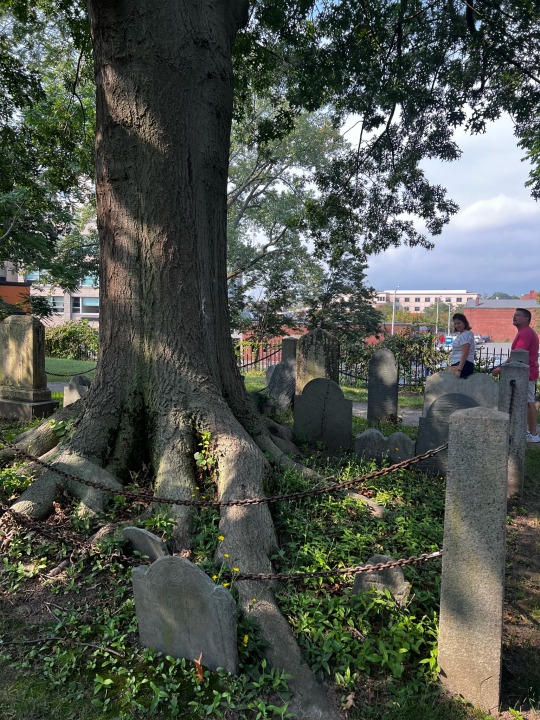
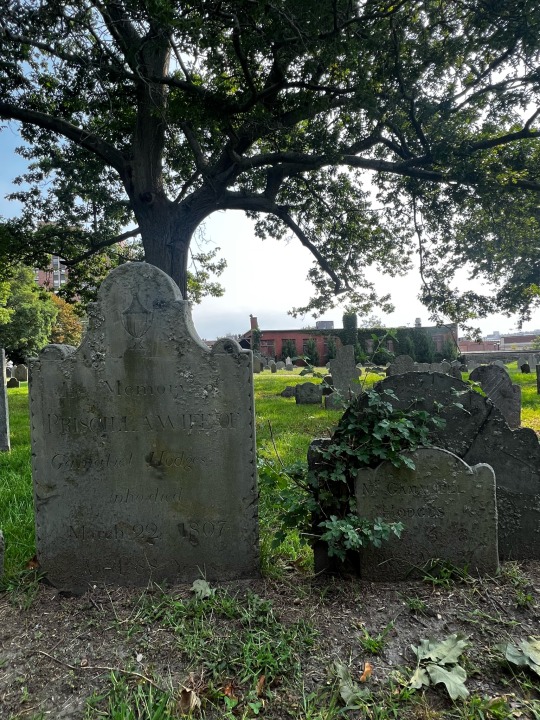



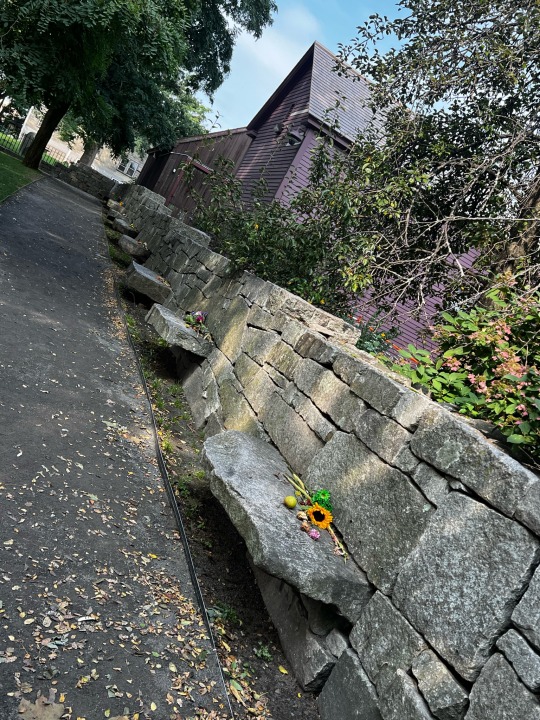
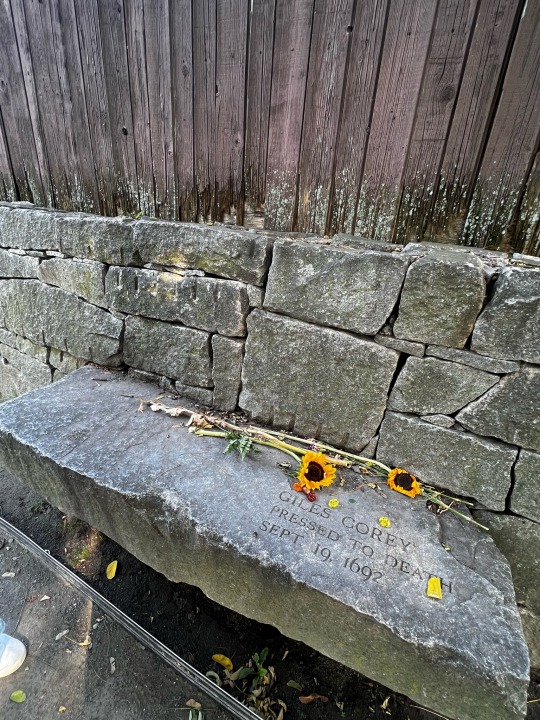
THINGS I LEARNED IN SALEM, DAY TWO:
The Salem Witch Trial Memorial was dedicated in the 90s by Elie Wiesel
It is absolutely crazy that more 20 people died in the span of like 3 months, and then, what—you just went back to normal? Looked these people in the eye afterwards?
One dude made like 84 of the tombstones in the old Salem cemetery. He favored the skull with windows decoration or the more distinctive urn with a willow frond coming out of it.
Cemetery drama: the only Mayflower pilgrim to settle in Salem is buried between his second wife and his “CHRISTIAN WIFE”
Also buried there: the Judge Hathorne who was the only one of the witch trial judges to never recant his judgement, an ancestor of Nathanial Hawthorne, who threw that w in there himself out of shame of association with the guy
Salem’s huge maritime industry meant it was a place for goods from India, China, Japan, all around the world—it was actually a super cosmopolitan and international spot.
According to my tarot reader, it’ll be an eventful but rewarding and exciting year, and when someone from my past reappears at the beginning of next summer all contrite I should NOT BELIEVE THEYVE CHANGED, THEY HAVENT, I GOTTA TELL THEM TO GTFO
#she also said i need to reckon with toxic masculinity and my relationship to my parents and like girl#what else is new amiright#Hannah hits the road#sparkly originals#just a like 30 hour trip but we packed it in tbh!!!!
12 notes
·
View notes
Text
The binding power of chthonic gods
Something I keep noticing in chthonic gods is that they often tend to be associated with the power of binding. By "chthonic gods", I tend to mean either gods of the underworld, gods who dwell beneath the earth, or god who are associated with some vital power or mystery associated with the underworld. I often kind of joke about it in relation to BDSM, but it's kind of worth discussing on its own.
I think I'll start with Odin, because that's usually where this theme starts for me. Even though Odin is not popular understood as a chthonic deity, owing to his status as the ruler of Aasgard and leader of the Aesir, many traits point to a very chthonic character. He was called the "lord of the gallows", and sometimes received hanged men as sacrificial offerings to the ravens. His many epithets included Valdrgalga ("ruler of the gallows"), Farmrgalga ("burden of the gallows"), Draugadrottin ("lord of the Draugr/undead"), and Foldardrottin ("lord of the earth"), all denoting his sovereignty via the chthonic realm. His horse Sleipnir allowed Odin as well as other deities to travel between worlds and particularly to the underworld. In some interpretations, even Valhalla may have been an underground place, or a kind of underworld in itself.

Anyways, the main connection to binding comes from the Valknut, a mysterious Germanic symbol likely associated with Odin. No one really knows its meaning, but the fact that it almost solely seems to appear in connection with the cult of the dead suggests that the symbol is tied to death in some way. The other major theory about the valknut is that it represented Odin's power to, in the others of Hilda Ellis Davidson, "lay bonds upon the mind, so that men became helpless in battle, and he could also loosen the tensions of fear and strain by his gifts of battle-madness, intoxication, and inspiration". In this understanding, the valknut represents Odin's power to bind and unbind the human mind, or more specifically those of his enemies and allies respectively, as well as the cycles of transition between death and rebirth.
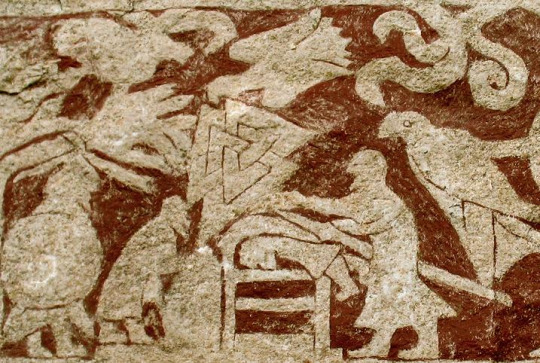
The binding and liberating aspect of chthonic power is also reflected in Kronos, or Saturn, one of the many chthonic gods seen in Greek and Roman polytheism. Throughout the Greek Magical Papyri, the "chains of Kronos" are apparently invoked as a binding force. In the "Prayer to Selene", within the Greek Magical Papyri, the goddess Hecate, as Selene, wears the chains of Kronos upon her body, as well as wielding a scepter made by Kronos, which gives her power over even the primordial chaos itself. The influence of Saturn has often been believed to involve binding in some way. At the same time, Saturn was also undoubtedly a god of liberation, honoured in festivals such as Saturnalia where the whole order of Roman society was temporarily inverted.

In Vedic India, two chthonic gods, Varuna and Yama, share the attribute of binding sinners or wrongdoers with a rope for judgement. In Varuna's case this is by way of the nagapasa, his weapon and instrument of justice. Varuna himself lived in the underworld, his "stone house" where the waters of his night sky also dwelled and into which the sun withdrew after dusk. Yama, as the first mortal who upon death became the lord of the departed, also dwells in the underworld, and presides over it as the judge of the souls of the deceased. Yama's rope was an instrument by which to "capture" the souls of people who are about to die so that he can deliver them to death. In the Brahma Purana, Yama attempts to capture Markandeya with that rope, but is saved by the intervention of the god Shiva.
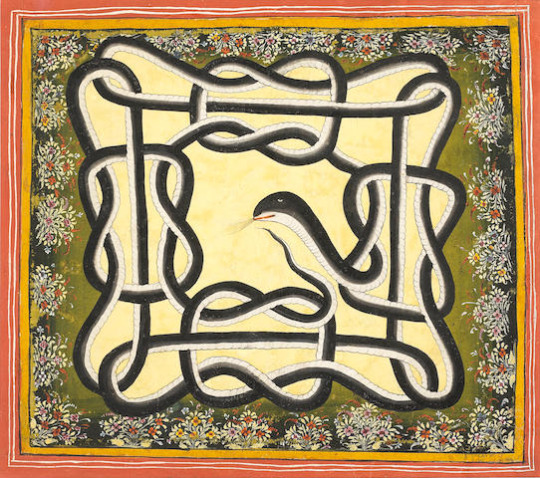
Varuna's and Yama's binding power is perhaps reflected in the Japanese Buddhist figure of Fudo Myo-O, one of the Vidyaraja (Wisdom Kings). Fudo Myo-O uses his rope to, depending on who you ask, bind each thing to its "nature", bind the ignorant, or capture demons. Fudo Myo-O, in his own way, has his own chthonian persona. Bernard Faure notes in Gods of Medieval Japan that Fudo was identified with the earth and thus positioned at the centre (or rather honzon) of earth-quelling rituals and identified with another earth deity named Kenro Jijin, as well as linked to a complex quasi-demonic deity named Kojin.

I won't go much further than I already have for this post, mostly to maintain to some sense of brevity for a Tumblr infodump. To round this out, though, I don't have that good an idea of why the chthonic powers are often tied to binding. But, if Odin and Saturn are any indication, maybe it's just a central part of the duality and polarity embodied by the chthonic realm, wherein the bondage of the chthonic powers is inseparable from a larger liberating power that, as I think Frater Archer said, is an essential part of the underworld, and the experience of mystery to which the underworld is central.
#chthonic gods#odin#yama#varuna#kronos#valknut#paganism#polytheism#saturn#underworld#binding#fudo myoo#chthonic
43 notes
·
View notes
Note
1. JK is from one of biggest anti LGBTQ country where people get attached for being queer
2. The death of migrant. From datas I saw majority are from India. And as an Indian I can understand this coz 1 out of every 4 houses here have atleast 1 person working in middle east countries especially from my state. And lemme tell you the celebrations of worldcup here is INSANE. Like you will be literally surprised how Grantly it's celebrated here and number of fans associations and 100ft cut outs of sports starts displayed here. I can, without a ounce of doubt, say people here doesn't give a fuck about country's rules or governance where world cup is happening.
And that's the attitude of majority of Asian countries and people there regarding many of rules and regulations prevailing in other countries... we only care how people we stan is personally and won't try to judge them based on the countries they may have to visit as part of job... because it's really 2 unrelated event for us.
Anon 2: I'm non binary and trans and I do feel very weird about Jungkook deciding to perform in a country that not only kills LGBTQ+ people, but has serious labor law violations, discriminates rampantly against women and is intolerant towards minorities. I feel so so so bad because I love him, I look up to him but then he went ahead and performed there. When he could've have simply chosen not too. And I'm not the only one in my community who feels this way. I feel immensely disappointed. And you might not agree with me, which is fine.
I'm not telling anyone how to feel. Everyone is entitled to their own opinions. I'm sharing how I FEEL. And I hope that you hold that same energy for all the other places BTS have performed in that have horrible and degrading laws towards queer people and women too over the past years. Like I said in my post addressing all this before. I won't be sharing anymore over this because I have said all I have to say. Which is not me telling you to agree with me. Feel how you feel. That's okay. It's me saying I'm not wanting to have the exact same conversation 10 times. Just to keep repeating myself and reminding everyone that their feelings are their own and doesn't need my validation either way, whether you are upset about it or not. I personally do not have the mental energy right now to validate everyone's feelings about it all personally. I already did so in a general sense and shared my own thoughts about it all. Please just go read that post. Thank you
32 notes
·
View notes
Note
Hey, I'm back and curious, in reference to the swastika and incidents surrounding it. This is neutral, I generally just want to see your opinion on it.
Obviously it is known for representing the holocaust, but it was around along time before ww2 as well. Unfortunately it gained a negative association because of nazi Germany, but prior to that it was and still is (I believe) a common symbol for religions in various Eurasian, as well as some African and American cultures. It continues to be used as a symbol of divinity and spirituality in Indian religions, including Hinduism, Buddhism, and Jainism.
Do you think the fact that ww2 was more recent unfortunately means that it cannot be used for its original meaning(s)?
I feel like it's a sticky situatikn sometimes the person may actually be referring to the original meaning? And maybe sometimes people are quick to judge? (I'm not saying in any way that Chaeyeoung wore the shirt for the original meaning of it) I just thought and realized what if someone has or will wear it and generally want to just represent their religion, like Hinduism or Buddhism, etc.
Sorry this is so long. I can message you privately if you prefer, so you don't have to keep answering these asks
hiiiii. so i've been thinking about this ask since i saw it this morning, and before i answer it, i just want to clarify that ultimately i'm no means an expert - my opinion is literally just my opinion. that being said, if anyone else sees this, i'm fine with answering asks related to this as long as people are respectful about it.
so i'm someone who is indian and who has been exposed to, as well as practiced, hinduism throughout the years. and you're right. in indian religions, the swastika is a religious symbol that is valued by many. it still is, especially in the east. but obviously that isn't the same in the west. one, because those religions aren't prominent in the west, and two, because of the association with nazi germany.
and so i think my answer to your question has to do with these two factors. what matters is the context. like... if i go back to india and see people using the swastika, particularly in their religious practices, i'm not going to assume they're all nazis. and i'm not going to tell them to not use the swastika either, because the symbol has been around since way before hitler used it. it absolutely should be allowed to be used for its original meanings.
however, i think this is a different situation in the west. and again, it has to do with the context. if i go into a hindu temple in north america, there is a chance i'll see the symbol. but does that mean that all the people who go to that temple are nazis? no. however, i would seriously question seeing the swastika in a non-religious setting anywhere else in the west. so to answer your question, in the west, i think it also depends on the context. people can use it for its original purpose, however, they need to be aware that the majority of people will associate the swastika with nazi germany. it's recency bias. so people need to be way more careful about how they use it in the west, even if they intend to use it for religious purpose.
so yeah. you're right about the sticky situation part. if we're looking at the context of chaeyoung's incident in particular, the swastika on the shirt was clearly related to nazi germany. people can be quick to judge, yes, but ultimately, other people using the symbol need to be aware of the contexts of the situations in which they're using it, especially in the west.
sorry this was so long, but i hope this helps :)
7 notes
·
View notes
Text

•
110
New Moon in Aquarius
21st of January 2023
Saturday 8:53 PM GMT
Aquarius rules over;
Humanitarian issues, collectivity, popular science/ scientific communities, friends, masses, unconventionality, suddenness, assertiveness, progression, analytical faculties, inventions, electricity, eccentricity, counselling and astrology etc,.
Ruling over the locomotive functions of the human organism - ankles and blood circulation.
Aquarius being a fixed air sign. Indicating towards a firmness in thought and opinions.
Governing places such as hilly uneven grounds, sources of springs, high places, skyscrapers, top floors, roofs, near windows ( where Air flows), lecture rooms, where computers or machinery is kept and aircrafts etc,.
Mundane
The Sun and Moon will be conjoined on the
1st degree of Aquarius. Placing an emphasis on all the mention themes associated to the sign.
Events of a cathartic nature may come along with the New Moon ( a week prior this can be observed ) - outcries, voiced opinions and aid of general people.
Unveiling of information connected to authority figures, mafia workings, terrorist groups, elderly, national death rates, epidemics and news of many unforeseen accidents.
Fiery displays from both the state and - general people - with the masses having an upper hand. Clashes between the right wing and left wing. All judicial, religious, martial and energy related threads will be frequent.
Revolutionary ideals will be made known, many uprisings and protests. New prominent scientific findings and a strict tactical push for implementations. Social media platforms and those which have a reach towards the collective will be prevalent in pushing storylines.
Finances, talks of peace, freedom, food, topics concerning women and artists are of key importance. Many exaggeration and cover ups will dominating.
As Mercury and Mars are both now direct.
Less blockages will be experienced.
Mercury enters its Exaltation in the sign of Aquarius on the 12th of February.
This New Moon will have particular importance upon some of the places mentioned below.
Canada, South America, USA (Central)
Iran, Iraq, Russia,
Pakistan, India, Hijaz,
China, Australia,
Spain, Morocco,
See which house in your chart is ruled by Aquarius ( 1st Degree) and judge accordingly.
Overall this New Moon is a positive one with enough will present to complete, carry out or begin new tasks.
Break through experiences and a great urge for different approaches.
and Allah (swt) knows best
#Painting Aphrodite#Astrology#New Moon#Sun#Moon#Venus#Mercury#Mars#Jupiter#Saturn#Uranus#Neptune#Pluto#Aquarius#Aries#Taurus#Gemini#Cancer#Leo#Virgo#Libra#Scorpio#Sagittarius#Capricorn#Pisces
4 notes
·
View notes
Text
Expert committee was constituted by Supreme Court in the wake of hindenberg report
Background of the case : Vishal Tiwari v. Union of India & Ors.
A bunch of 04 Writ Petitions have been filed before the #SupremeCourt of India in the wake of #Hindenberg Report.
The report alleges, that the #Adani Group of companies has manipulated its share prices; failed to disclose transactions with related parties and other relevant information concerning related parties in contravention of the regulations framed by SEBI; and violated other provisions of securities laws. The report also states that Hindenburg Research has taken a short position in the Adani Group companies through US traded bonds and non-Indian traded derivative instruments.
Directions sought in Writ Petitions
The 04 #WritPetitions separately seek directions from the Apex Court;
Directions to the Union of India and the #UnionMinistryofHomeAffairs to constitute a committee headed by a retired judge of the Supreme Court to investigate the contents of the report published by Hindenburg Research;
Directions to the Union Ministry of Home Affairs to register an #FIR against Mr. Nathan Anderson (#founder of Hindenburg Research) and his associates for short selling, and for directions to recover the profits yielded by the short selling to compensate investors;
Sought a #courtmonitoredinvestigation by a #SpecialInvestigationTeam or by the Central Bureau of Investigation into the allegations of fraud and the role played by top officials of leading public sector #banks and other #lender institutions
Sought directions to any investigative authority to: (i) investigate the Adani Group companies under the supervision of a sitting judge of this Court; and (ii) investigate the role of LIC and SBI in these transactions.
Expert Committee Constituted by Apex Court
The Bench of the Apex Court comprising Hon’ble CJI Dr. D Y Chandrachud, Hon’ble Justice P S Narasimha & Hon’ble Justice J B Pardiwala vide their order dt. 02.03.23 constituted an Expert committee to protect the investors from the volatility of the kind headed by Justice Abhay Manohar Sapre, a former judge of the Supreme Court. The committee comprises Mr. O P Bhatt, Justice J P Devadhar (retired), Mr. KV Kamath,Mr. Nandan Nilekani & Mr. Somashekhar Sundaresan.
Report in two months
The Committee is requested to furnish its report in sealed cover to this Court within two months.
The Committee shall remit on the following:
Provide overall assessment of the situation including the relevant causal factors which have led to the volatility in the securities market in the recent past;
To suggest measures to strengthen investor awareness;
To investigate whether there has been regulatory failure in dealing with the alleged contravention of laws pertaining to the securities market in relation to the Adani Group or other companies; and
To suggest measures to (i) strengthen the statutory and/or regulatory framework; and (ii) secure compliance with the existing framework for the protection of investors.
The Apex Court in its order dt. 10.02.2023 noted the need of reviewing existing regulatory mechanisms in the financial sector to protect Indian investors from volatilities in the market. And suggested Solicitor General of India that to seek instructions from the Union of India on the constitution and remit of an expert committee.
SEBI’s suggestion for securing the interest of the investors:
Mandatory disclosures by listed companies to facilitate free and fair price discovery and to ensure that all investors have equal access to material information for them to be able to take informed investment decisions;
Market systems to ensure seamless trading and settlement including volatility management;
Enforcement action in the event of misconduct in the market including fraud or violations of SEBI regulations.”
With respect to the aforesaid Writ Petitions SEBI submitted, it is already enquiring into, the allegations made in the Hindenburg report as well as the market activity immediately preceding and post the publication of the report and it will not be appropriate to report the details at this stage.
Seema Bhatnagar
1 note
·
View note
Text
So I wanted it to add a fun picture of a Victorian stripper, as your neighbourhood Tumblr historian, but turns out the history of Pole Dancing is far more intersting than that! (Also, opinions differ on this stuff and different sites have different stories, I'm just going with the Wikipedia person!)
The idea of dancing with a pole began with Mallakhamba in India where it is still done;
youtube
I'll just quote Wikipedia now "Pole dance in America has its roots in the "Little Egypt" traveling sideshows of the 1890s [....] in an era where women dressed modestly in corsets, the dancers, dressed in short skirts and richly adorned in jewelry, caused quite a stir.[13][14] During the 1920s, dancers introduced pole by sensually gyrating on the wooden tent poles to attract crowds."
Ok, so sources highly disagree about the specifics, but everyone roughly agrees pole dancing entered America by the 1920s and probably under the influence of Britian through Egypt and then through fairs, but I don't know the details. Some also suggest it was "dansers doing ''hoochie coochie" dances, which were a type of belly dance, but including the poles of the circus they worked in. Roughly the same logic, but a little different. At least some vague "fair/circus/Middle Eastern but still in the US but travelling" type of origin.
I've tried to find any examples of all of this, but of course these things were seldom fotographed, let alone made easy to find on the internet. The hoochie coochie dances are better documented though (TW; it's the 1920s so orientalism and probably racism and sexualisation of women although that's hard to judge, just, you know, it's 1920s entertainment about the 'lesser' part of society);
The thing was already common in the 1890s in a 'modest form';
youtube
youtube
youtube
From when Disney was still....not the family company it is today.
The dances, term and the whole concept are still common on American fairs such as showcased in this song from 2021 (also, why is there a Dutch flag in this video for no reason?!?!?!?!). It shows how in the 1920s the women danced with a lot more skin exposed than in 1896;
youtube
(Yeah, don't get me started on how problematic all this stuff is. It's La Belle Epoque we're talking about!)
Anyway, I'm getting of track. In the 1950s and 60s with the sexual revolution, Brulesque as a form of dance was introduced. Brulesque was a term that had existed for a long time (a lot of classical peaces are called "Brulesque Waltz" or something like that), but was only now becoming associated with red lights.
Elvis Presley's "Jailhouse Rock" from 1957 is partially to blame for this. "The video featured Presley's famous gyrating hips as well as numerous pole slides, grinds, and twirls." Some sources mention Belle Jangles as the first to amaze people with a pole dance during her striptease thereby inventing the "striptease+pole" combination.
Then in the 1990s Fawnia Mondey, known as the world's first pole dancing instructor, began teaching pole dancing as a craft. (Notice she was the first person to treat it as a craft, where as people before her always treated it like a part of a bigger dance or seduction routine.)
BUT I'M STILL NOT DONE. It's totally unrelated but I wanna share the horizontal version of this practice, using roughly the same ideas of wrapping your body around a wooden or metal pole, but now horizontally. (Although this one has origins in Ancient Greece and has been part of the Olympics since forever. A bit like those oval running fields.)
This one exists in two variants as far as I'm aware. The "long" variant is the horizontal bar part of artistic gymnastics and is part of the Olympics. The "short" variant is done on Dutch playgrounds and has A LOT of different names, although usually called "duikelen". It is mostly done by girls around the age of 9 or 'groep 5'. The tricks began as girls just doing things from their gymnastics routines at school but eventually became its own "I'm better than you" children's culture. (I was one of the leaders even though I didn't go to any gymnastics classes. I just did what everyone else did. But that showed it really became a thing of its own.)
This very 2007 video shows 'the basic tricks' although by far not all of them (I'm gonna make a seperate post naming all of them because for some reason no one has done that yet!);
youtube
So yeah, sorry for the rant, but that's the short history of Pole Dancing. ;)
Is Pole Dance the same as Stripping?
I get a lot of comments saying something like “bro is a striper” (usually when a post breaks containment), so thought I might as well address the topic!
Please consider supporting me on Patreon if you like my videos!
35K notes
·
View notes
Text
Trolls will be unemployed after my retirement, quips CJI Chandrachud
New Delhi, Nov 8: Chief Justice of India (CJI) D.Y. Chandrachud, who is set to retire in two days, on Friday said that he is probably one of the most trolled judges across the system. In his address at the farewell function organised by the Supreme Court Bar Association (SCBA), CJI Chandrachud said: “All of you are aware of the amount that I have received my share of trolling.
0 notes
Text
[ad_1] Manu Bhaker with Jaspal Rana (PC: Manu Bhaker/X) The 100-day break prescribed by Dronacharya Jaspal Rana for Manu Bhaker, Paris Olympics star, is over. It will be back to the grind from this week in Dehradun at his own ranges. “A long break was needed, and, at the same time, I had asked Manu to keep working on her fitness,” Rana told RevSportz on Wednesday. “She has been doing the fitness routines and we are looking forward to starting from scratch all over again.” To be away from the shooting ranges for over three months was something Manu enjoyed. She was able to take her Masters exams in Public Administration from Chandigarh, and is looking forward to returning to shooting. “I am happy she could pursue her dream of higher education,” said Rana. “It is important to pursue your dreams. Now begins the grind all over again. Manu has to forget she won two medals in Paris and finished fourth in the sports-pistol event. All that is past, looking ahead, she has to again train the same hard way, and there will be no short cuts.” He has been in constant touch with his favourite ward, even as he mentors a few more shooters in the trap discipline, including Ria Rajeshwari Kumari and Kynan Chenai. Rana is also helping out a few more juniors, but the focus will be back on Manu. “The first thing will be to get her shooting muscle memory back and then build on it,” he said. “The initial plan was she shoots at least 100 rounds each week even during the break period, but that did not happen regularly. She did come to the Siri Fort ranges in New Delhi last month and is eager to come back.” Probed further on why Manu will get so special treatment after such highs this year, Rana was frank. “What she did and achieved is past,” he said. “Reputation alone will not take you forward. Hard work has to go in again, and there is no hurry at all. We are not targeting that she shoots in competitions before 2025, so she will have ample time to train and work on her technique.” For the Latest Sports News: Click Here Manu Bhaker talking with Jaspal Rana (PC: Manu Bhaker/X) The National Rifle Association of India (NRAI) will be holding the Nationals in New Delhi at the Karni Singh ranges in December. Manu will not be part of that. As in the past, when Manu reached out to Rana in May 2023 so that he could again train her, the two will look to put in hard hours in Dehradun. “The kind of form Manu was in during this summer and the Olympic selection trials, she needs to get there again,” said Rana. “The approach has to be systematic, with consistent hard work and focus. The way she shot in Bhopal in the final trial and sealed her participation in three events at the Paris Olympics, that was good. At the same time, some of the other shooters had not peaked in Bhopal.” He felt that when Manu returns to competition, few other shooters would be in a good rhythm. “If she starts shooting competitions in 2025 and is again part of the regular trials conducted by the federation, she will get into her rhythm,” he said. “People are talking of the 2028 Olympics in Los Angeles for Manu. No, she first has to peak for the Asian Games in Nagoya in 2026. That will again be through trials and competitions to judge which shooters are in top form. There are absolutely no short cuts ahead, I am clear about that. Yes, it is exciting Manu will be back at the ranges, because she loves the sport.” Is there a possibility that more shooters will be wanting to have a go at Manu in competitions and trials? “Of course, there are plenty of pistol shooters who are already training,” said Rana. “They will want to do well, so my plan is that Manu is ready to face stiff competition from January 2025. I repeat, no short cuts.” Also Read: Jeddah to host 2025 IPL mega auction on November 24 and 25 The post Coach Jaspal Rana says no short cuts as Manu Bhaker resumes training appeared first on Sports News Portal | Latest Sports Articles | Revsports. [ad_2] Source link
0 notes
Text
My critique of these outfits. I am not a professional and these are just opinions.
Bolivia: Festive and inspired. Unmistakable South American vibes. I dig it. 7/10
Brazil: What the hell? Did you get this outfit from Spirit Halloween? I know you can do better Brazil. 2/10
Cambodia: Back to some traditional garb. I like it. 7/10
Cuba: Who's uncle is this? Non-offensive, but just normal. 5/10
Czechia: Not bad. Feels historic but lacks a little bang. 6/10
Dominican Republic: I'm sorry, I can't hear you over the sound of those tights screaming against those muscular thighs. Almost enough to make me forget the colonialism associated with that outfit. 8/10
Ecuador: Alright, I see most of South America decided to use the same playbook. Each distinct, but similar vibe. 7/10
France: What are you doing France? It feels like you tried to steal South America's homework. This feels wrong, and no amount of sexy abs is going to distract me from that. 2/10
Hong Kong: Ok now, this I like. This feels both traditional and modern. I see we are trying to bribe the judge again with sexy abs.... I'll allow it. 9/10
India: This looks very nice. Elegant and professional vibe. A look I wish was actually more common. 8/10
Indonesia: This is interesting. Furry, but has an almost Mortal Kombat vibe to it. I'm intrigued. 8/10
Japan: I've definitely seen this look before. Was it the fisherman or during one of the festivals? Like the jacket, but the back profile means that I can't see the full outfit. And it's just long enough to be a tease. Shorts? A fundoshi? Show me the goods Japan!!! 6/10
Laos: Kung Lao? Is that you? Not bad, but not too memorable. 6/10
Macau: Are you wearing a transparent suit over swim trunks? I am perplexed. 4/10
Malaysia: Alright sir, I'll keep it real for you. The outfit is an ok tan suit with a nice turban. The pose though makes me curious about the movie that you are the lead in. 6/10
Mexico: Vibrant South American vibes. +0.5 for the Bi pride colors. 7.5/10
Myanmar: I just feel calm looking at you. You look so chill and peaceful that I just feel relaxed. Soft vibes. 7/10
Nigeria: TAJADOR!!! (Yes, that is a Kamen Rider OOO reference) Serious red bird vibes. 7/10
Panama: Namor? Seriously, Wakanda Forever's Namor is all I can see. 6/10
Peru: Sexy scantily clad man covered in gold, eh? I've warned you all about trying to bribe the judge... 9/10
Philippines: Who is responsible for the copypasta of homework? Yes it looks fine, but seriously people. 7/10
Puerto Rico: You look exhausted after spending a long day out in the fields. 6/10
Romania: Nice traditional garb. The head ornament is a bit distracting. 6/10
South Africa: Queen Titania, I didn't realize you would be joining us. Bold choice. 8/10
South Korea: Thank you for not trying to bribe the judge. Very strong Joseon vibes. Good luck on the imperial exams. 7/10
Spain: Ferdinand, I don't care what you or Isabella have to say about the Inquisition, you in fact DID NOT have to do it to them. 3/10
Sri Lanka: Sir, you look fabulous. 8/10
Switzerland: Go home, you are drunk. 2/10
Thailand: So we got the gold covered man, but looks like he is actually inspired by some traditional art instead of just eye candy for the judge. 9.5/10
United Kingdom: Oi guvner! Dis here is a competition, and you are just some bloke. 1/10
USA: What the hell is this? You and France copied the homework of South America, and you look silly. Nope. DQ. -2/10
Venezuela: Did you even try? Boring. 2/10
Vietnam: Ok, what kinda god are you supposed to be, and what are your myths. I must know. I see we are still using the sexy abs, but now we have the thin hair line down the stomach to... ahem. See me after the competition sir. 10/10
brb the whole discord in an uproar at the UNCONSCIONABLE results of Mister Global 2022
130K notes
·
View notes
Text
[ad_1] Manu Bhaker with Jaspal Rana (PC: Manu Bhaker/X) The 100-day break prescribed by Dronacharya Jaspal Rana for Manu Bhaker, Paris Olympics star, is over. It will be back to the grind from this week in Dehradun at his own ranges. “A long break was needed, and, at the same time, I had asked Manu to keep working on her fitness,” Rana told RevSportz on Wednesday. “She has been doing the fitness routines and we are looking forward to starting from scratch all over again.” To be away from the shooting ranges for over three months was something Manu enjoyed. She was able to take her Masters exams in Public Administration from Chandigarh, and is looking forward to returning to shooting. “I am happy she could pursue her dream of higher education,” said Rana. “It is important to pursue your dreams. Now begins the grind all over again. Manu has to forget she won two medals in Paris and finished fourth in the sports-pistol event. All that is past, looking ahead, she has to again train the same hard way, and there will be no short cuts.” He has been in constant touch with his favourite ward, even as he mentors a few more shooters in the trap discipline, including Ria Rajeshwari Kumari and Kynan Chenai. Rana is also helping out a few more juniors, but the focus will be back on Manu. “The first thing will be to get her shooting muscle memory back and then build on it,” he said. “The initial plan was she shoots at least 100 rounds each week even during the break period, but that did not happen regularly. She did come to the Siri Fort ranges in New Delhi last month and is eager to come back.” Probed further on why Manu will get so special treatment after such highs this year, Rana was frank. “What she did and achieved is past,” he said. “Reputation alone will not take you forward. Hard work has to go in again, and there is no hurry at all. We are not targeting that she shoots in competitions before 2025, so she will have ample time to train and work on her technique.” For the Latest Sports News: Click Here Manu Bhaker talking with Jaspal Rana (PC: Manu Bhaker/X) The National Rifle Association of India (NRAI) will be holding the Nationals in New Delhi at the Karni Singh ranges in December. Manu will not be part of that. As in the past, when Manu reached out to Rana in May 2023 so that he could again train her, the two will look to put in hard hours in Dehradun. “The kind of form Manu was in during this summer and the Olympic selection trials, she needs to get there again,” said Rana. “The approach has to be systematic, with consistent hard work and focus. The way she shot in Bhopal in the final trial and sealed her participation in three events at the Paris Olympics, that was good. At the same time, some of the other shooters had not peaked in Bhopal.” He felt that when Manu returns to competition, few other shooters would be in a good rhythm. “If she starts shooting competitions in 2025 and is again part of the regular trials conducted by the federation, she will get into her rhythm,” he said. “People are talking of the 2028 Olympics in Los Angeles for Manu. No, she first has to peak for the Asian Games in Nagoya in 2026. That will again be through trials and competitions to judge which shooters are in top form. There are absolutely no short cuts ahead, I am clear about that. Yes, it is exciting Manu will be back at the ranges, because she loves the sport.” Is there a possibility that more shooters will be wanting to have a go at Manu in competitions and trials? “Of course, there are plenty of pistol shooters who are already training,” said Rana. “They will want to do well, so my plan is that Manu is ready to face stiff competition from January 2025. I repeat, no short cuts.” Also Read: Jeddah to host 2025 IPL mega auction on November 24 and 25 The post Coach Jaspal Rana says no short cuts as Manu Bhaker resumes training appeared first on Sports News Portal | Latest Sports Articles | Revsports. [ad_2] Source link
0 notes
Text
Delhi lawyers to strike on November 4. Court case confrontation led to action
The conflict between lawyers and the District Judge at Ghaziabad Court in Uttar Pradesh has worsened. This incident is being criticized by everyone involved. Legal groups have condemned the law enforcement’s use of lathi on the legal professionals. The Supreme Court Bar Association and the All India Lawyers Union, the All India Organization of Lawyers, have criticized this event and urged for a…
0 notes